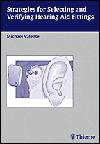This current and expanded edition of a bestselling text is
divided into four sections, organized to follow the sequence in
which decisions are made regarding hearing aid fittings, and
featuring new chapters on middle ear implants, hearing aid
counseling, and infection control. Other chapters have been
revised to reflect the latest developments in the field, such
as: improving speech recognition with directional microphones;
changing standards for measuring real-ear performance; and new
prescriptive procedures for severe hearing loss.
The text features contributions from internationally renowned
experts in the field who share their extensive knowledge and
clinical experience. It covers the six most common forms of
hearing loss practitioners will encounter in their own practice--
noise-induced, symmetrical, asymmetrical, unilateral,
conductive, and severe hearing loss--with instructions on
applying the newest technology to each hearing impaired group.
Key features:
·Addresses the six most common types of hearing loss that
comprise 90-95% of the situations audiologists encounter daily
·Organized to follow the decision-making progress in selecting
and verifying hearing aid fittings
·Fully updated with state-of-the-art technology on implantable
hearing aids, directional microphones, and more
·A valuable glossary of terms at the end of the text--helpful
for students and specialists alike
Together with its updated companion text, HEARING AIDS:
STANDARDS, OPTIONS, AND LIMITATIONS, this book forms the basis
of a complete reference library on selecting, ordering,
measuring, and verifying hearing aid fittings and performance.
Strategies for Selecting and Verifying Hearing Aid Fittings
TABLE OF CONTENTS
Preface
Contributors
1 Overview and Rationale for Prescriptive Formulas for Linear and Nonlinear
Hearing Aids 1
2 Selection, Verification, and Validation of Maximum Output 23
3 Real-Ear Measures 66
4 Paired Comparisons as a Fine-Tuning Tool in Hearing Aid Fittings 125
5 Assessing Hearing Aid Fittings: An Outcome Measures Battery Approach 151
6 Fitting Strategies for Noise-Induced Hearing Loss 176
7 Fitting Strategies for Patients with Symmetrical Hearing Loss 202
8 Fitting Binaural Amplification to Asymmetrical Hearing Loss 221
9 Fitting Strategies for Patients with Unilateral Hearing Loss 253
10 Fitting Strategies for Patients with Conductive or Mixed Hearing Loss 272
11 Middle Ear Implants: An Alternative to Conventional Amplification 287
12 Hearing Rehabilitation for Individuals with Severe and Profound Hearing
Impairment: Hearing Aids, Cochlear Implants, and Counseling 311
13 Hearing Aid Orientation and Counseling 345
14 Hearing Aid Related Infection Control 369
Index 384


